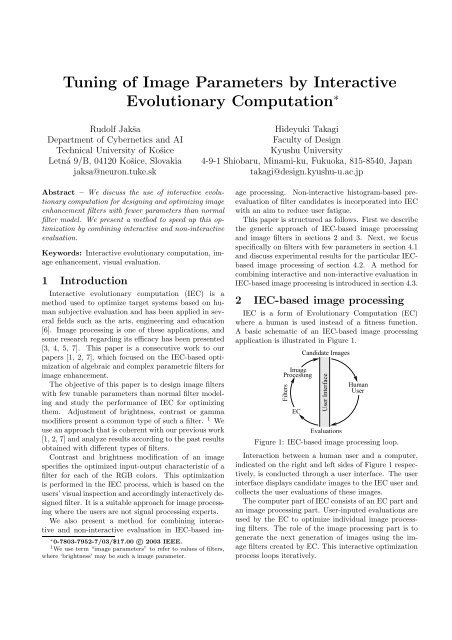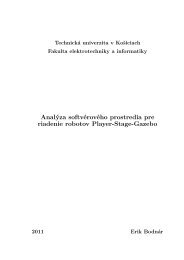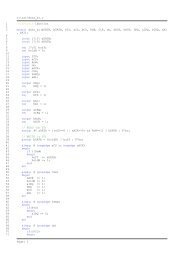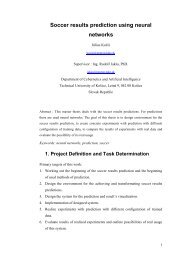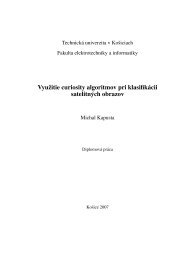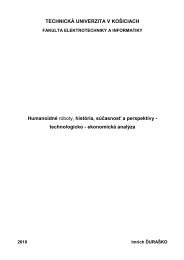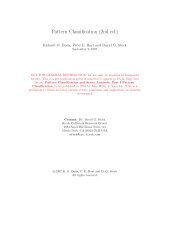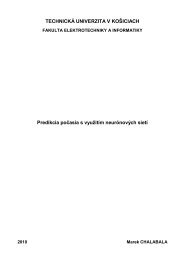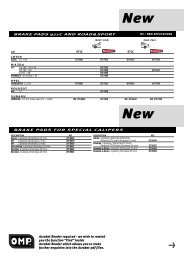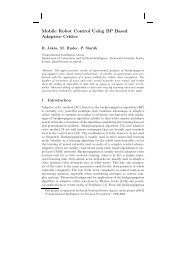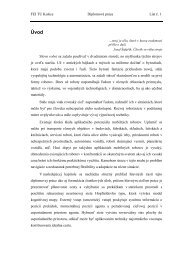Tuning of Image Parameters by Interactive Evolutionary ... - TUKE
Tuning of Image Parameters by Interactive Evolutionary ... - TUKE
Tuning of Image Parameters by Interactive Evolutionary ... - TUKE
You also want an ePaper? Increase the reach of your titles
YUMPU automatically turns print PDFs into web optimized ePapers that Google loves.
<strong>Tuning</strong> <strong>of</strong> <strong>Image</strong> <strong>Parameters</strong> <strong>by</strong> <strong>Interactive</strong><br />
<strong>Evolutionary</strong> Computation ∗<br />
Rudolf Jakˇsa<br />
Department <strong>of</strong> Cybernetics and AI<br />
Technical University <strong>of</strong> Koˇsice<br />
Letná 9/B, 04120 Koˇsice, Slovakia<br />
jaksa@neuron.tuke.sk<br />
Abstract – We discuss the use <strong>of</strong> interactive evolutionary<br />
computation for designing and optimizing image<br />
enhancement filters with fewer parameters than normal<br />
filter model. We present a method to speed up this optimization<br />
<strong>by</strong> combining interactive and non-interactive<br />
evaluation.<br />
Keywords: <strong>Interactive</strong> evolutionary computation, image<br />
enhancement, visual evaluation.<br />
1 Introduction<br />
<strong>Interactive</strong> evolutionary computation (IEC) is a<br />
method used to optimize target systems based on human<br />
subjective evaluation and has been applied in several<br />
fields such as the arts, engineering and education<br />
[6]. <strong>Image</strong> processing is one <strong>of</strong> these applications, and<br />
some research regarding its efficacy has been presented<br />
[3, 4, 5, 7]. This paper is a consecutive work to our<br />
papers [1, 2, 7], which focused on the IEC-based optimization<br />
<strong>of</strong> algebraic and complex parametric filters for<br />
image enhancement.<br />
The objective <strong>of</strong> this paper is to design image filters<br />
with few tunable parameters than normal filter modeling<br />
and study the performance <strong>of</strong> IEC for optimizing<br />
them. Adjustment <strong>of</strong> brightness, contrast or gamma<br />
modifiers present a common type <strong>of</strong> such a filter. 1 We<br />
use an approach that is coherent with our previous work<br />
[1, 2, 7] and analyze results according to the past results<br />
obtained with different types <strong>of</strong> filters.<br />
Contrast and brightness modification <strong>of</strong> an image<br />
specifies the optimized input-output characteristic <strong>of</strong> a<br />
filter for each <strong>of</strong> the RGB colors. This optimization<br />
is performed in the IEC process, which is based on the<br />
users’ visual inspection and accordingly interactively designed<br />
filter. It is a suitable approach for image processing<br />
where the users are not signal processing experts.<br />
We also present a method for combining interactive<br />
and non-interactive evaluation in IEC-based im-<br />
∗ 0-7803-7952-7/03/$17.00 c○ 2003 IEEE.<br />
1 We use term “image parameters” to refer to values <strong>of</strong> filters,<br />
where ‘brightness’ may be such a image parameter.<br />
Hideyuki Takagi<br />
Faculty <strong>of</strong> Design<br />
Kyushu University<br />
4-9-1 Shiobaru, Minami-ku, Fukuoka, 815-8540, Japan<br />
takagi@design.kyushu-u.ac.jp<br />
age processing. Non-interactive histogram-based preevaluation<br />
<strong>of</strong> filter candidates is incorporated into IEC<br />
with an aim to reduce user fatigue.<br />
This paper is structured as follows. First we describe<br />
the generic approach <strong>of</strong> IEC-based image processing<br />
and image filters in sections 2 and 3. Next, we focus<br />
specifically on filters with few parameters in section 4.1<br />
and discuss experimental results for the particular IECbased<br />
image processing <strong>of</strong> section 4.2. A method for<br />
combining interactive and non-interactive evaluation in<br />
IEC-based image processing is introduced in section 4.3.<br />
2 IEC-based image processing<br />
IEC is a form <strong>of</strong> <strong>Evolutionary</strong> Computation (EC)<br />
where a human is used instead <strong>of</strong> a fitness function.<br />
A basic schematic <strong>of</strong> an IEC-based image processing<br />
application is illustrated in Figure 1.<br />
<strong>Image</strong><br />
Processing<br />
Filters<br />
EC<br />
Candidate <strong>Image</strong>s<br />
User Interface<br />
Evaluations<br />
Human<br />
User<br />
Figure 1: IEC-based image processing loop.<br />
Interaction between a human user and a computer,<br />
indicated on the right and left sides <strong>of</strong> Figure 1 respectively,<br />
is conducted through a user interface. The user<br />
interface displays candidate images to the IEC user and<br />
collects the user evaluations <strong>of</strong> these images.<br />
The computer part <strong>of</strong> IEC consists <strong>of</strong> an EC part and<br />
an image processing part. User-inputed evaluations are<br />
used <strong>by</strong> the EC to optimize individual image processing<br />
filters. The role <strong>of</strong> the image processing part is to<br />
generate the next generation <strong>of</strong> images using the image<br />
filters created <strong>by</strong> EC. This interactive optimization<br />
process loops iteratively.
In the field <strong>of</strong> image processing, IEC is applicable in<br />
two partly different situations:<br />
a) if a user is looking for a particular filter or features,<br />
she/he can develop it or find it in this process, and<br />
b) if the user wants to find some new unknown features<br />
<strong>of</strong> a certain image – to explore the image – she/he<br />
can accomplish that through this process, as well.<br />
The result in case a) is the last filter obtained in IEC<br />
session, while in case b) it is an interactive process as<br />
whole; case a) represents an exploitative behavior, while<br />
case b) the explorative one.<br />
Genetic Algorithms (GA) and Genetic Programming<br />
(GP) with algebraic operations have been used for IECbased<br />
filter design for parametric filters and for classical<br />
image processing filters. The trade<strong>of</strong>f between using different<br />
variations on these methods and structures is not<br />
well studied yet. There are no established real-world<br />
applications <strong>of</strong> IEC-based image processing.<br />
2.1 User interface<br />
An important component <strong>of</strong> IEC is the Graphical<br />
User Interface (GUI), because the interaction between<br />
computer and user is an essential part <strong>of</strong> the IEC algorithm.<br />
This is an exception in EC area and also in<br />
wider context <strong>of</strong> computational intelligence.<br />
In image processing applications, the most basic role<br />
<strong>of</strong> the GUI is to display sets <strong>of</strong> images to the user (see<br />
Figure 8). The impression <strong>of</strong> the GUI is dramatically<br />
different if it is used to display 10 images at once or<br />
to display 100 images at once. Because <strong>of</strong> the limited<br />
capacity <strong>of</strong> the computer display and the need to display<br />
several images in parallel, there are two trade-<strong>of</strong>fs in<br />
design <strong>of</strong> GUI:<br />
1. The trade-<strong>of</strong>f between the ability to see details in<br />
the image and ability to see the overall appearance<br />
<strong>of</strong> image. This is balanced <strong>by</strong> usage <strong>of</strong> zooming<br />
and/or cropping <strong>of</strong> the image (displaying only a<br />
part <strong>of</strong> it).<br />
2. The trade-<strong>of</strong>f between the ability see details in the<br />
single image and ability to grasp its relation to<br />
other displayed images. If we reduce the size <strong>of</strong> population<br />
too much, the optimization performance<br />
may be limited. If we display only a portion <strong>of</strong> population<br />
at once, the ability <strong>of</strong> user to compare particular<br />
individuals may be limited, as she/he must<br />
recall non-displayed images.<br />
Another role <strong>of</strong> GUI is to collect users’ evaluations. This<br />
may be configured in several ways too. The user may<br />
search and pick out interesting images, select and evaluate<br />
best images, precisely evaluate all images, etc. Furthermore,<br />
there is a difference between continuous and<br />
discrete evaluation, as well as between 3-value and 5value<br />
ones. If the user is looking for any interesting<br />
features <strong>of</strong> the image and wants to see a lot <strong>of</strong> different<br />
views <strong>of</strong> the image, he/she will be frustrated <strong>by</strong> the<br />
need to precisely evaluate every single image. If the<br />
user knows the target filter behavior, she/he may want<br />
to precisely evaluate slightly different images in order to<br />
fine tune the resulting filter.<br />
User interface handles two information flows: one<br />
from computer to human and the other from human to<br />
computer. The total bandwidth <strong>of</strong> the information flow<br />
through the user interface is then the sum <strong>of</strong> these two<br />
flows. We may assume that a higher bandwidth means<br />
a deeper interaction. The information exchanged in interactions<br />
may, however, differ dramatically in quality.<br />
If using more expressive image presentations, the user<br />
evaluations may be more accurate and may lead to faster<br />
convergence <strong>of</strong> the search. To measure quality <strong>of</strong> presented<br />
information, a sum <strong>of</strong> consequent future evaluations<br />
might be used.<br />
3 <strong>Image</strong> Processing Filters<br />
3.1 Algebraic Filters<br />
Algebraic filters [7] compute the output pixel value<br />
using input pixel information and an arbitrary mathematical<br />
function to describe the input/output relation.<br />
To evolve such a filter the natural choice is to use GP<br />
methods, since they can build the structure <strong>of</strong> the function<br />
and also optimize its parameters. However, it’s<br />
possible to build such a filter with predefined structure<br />
type using a simple GA for its optimization.<br />
Input <strong>Image</strong> Output <strong>Image</strong> Input <strong>Image</strong> Output <strong>Image</strong><br />
Figure 2: One-to-one and several-to-one pixel mapping<br />
filter.<br />
The following mathematical function is an example <strong>of</strong><br />
an algebraic filter as discussed:<br />
rout = 100 sin(rin/20) + 50 log(gin) − 120 + rin/bin (1)<br />
Here, rout is the intensity <strong>of</strong> the output pixel in its red<br />
channel and rin, gin and bin are its input intensities in<br />
the red, green and blue channels. This filter realizes a<br />
one-to-one mapping <strong>of</strong> pixels in an image. To be able<br />
to achieve edge detection or other operations which rely<br />
on relationships between different pixels in an input image,<br />
we must include several input pixels in the filter<br />
function.<br />
An algebraic filter function for implementing a<br />
several-to-one pixel mapping may take the following<br />
form:<br />
rout = 0.2r−1,0 + r0,0 + 0.1g0,−1 + 0.2g0,0 − 0.1g0,1 (2)<br />
Where r−1,0 is the red channel intensity <strong>of</strong> the pixel at<br />
the position (−1, 0), (left) <strong>of</strong> the current pixel.
pixel value<br />
pixel value<br />
max. pixel value<br />
filter output<br />
max. pixel value<br />
filter output<br />
pixel value<br />
pixel value<br />
max. pixel value<br />
filter output<br />
min. and max. values <strong>of</strong> pixel<br />
filter output<br />
min. and max. values <strong>of</strong> filter output<br />
Figure 3: Functions to limit the pixel value and autoscaling<br />
method.<br />
An image’s maximal pixel intensity value is usually<br />
limited to 8, 12, 16, etc. bits per pixel. When using<br />
an arbitrary mathematical function to compute pixel<br />
value, this maximal pixel value may be easily exceeded.<br />
To address this problem, we must limit the output <strong>of</strong><br />
the filter again to the dynamic range <strong>of</strong> image. We may<br />
use limiting functions to do this, such as those shown<br />
in Figure 3. All these functions are nonlinear and may<br />
have a dramatic impact on the function <strong>of</strong> the filter.<br />
To overcome this nonlinear behavior, an auto-scale<br />
method may be used instead <strong>of</strong> these limiting functions.<br />
However, the auto-scale method is specific to a given<br />
filter and may be image specific and this may prohibit<br />
the use <strong>of</strong> given filter with other images and/or may<br />
affect the dynamics <strong>of</strong> the IEC search process. Also, the<br />
dynamic range <strong>of</strong> the output image will be fixed when<br />
using the auto-scale method; the brightest and darkest<br />
pixels will be always <strong>of</strong> the same intensity.<br />
Why not employ an IEC optimization method to also<br />
optimize the limiting function? In the ideal situation,<br />
the output <strong>of</strong> the filter function will never exceed the<br />
maximal value <strong>of</strong> pixel, and thus we wouldn’t need a<br />
limiting function. However, the initial filters in IEC<br />
image processing are not optimal (usually random) and<br />
the optimal solution is found through the optimization<br />
process. Therefore, if we use filters which are able to<br />
exceed the permitted range, in order for the process to<br />
proceed correctly we must explicitly limit the output<br />
pixel values to the correct range.<br />
3.2 Parametric Filters<br />
Parametric filters with fixed structure are based on<br />
parametric functions, and IEC is used only to optimize<br />
their parameters. If the number <strong>of</strong> parameters is fixed, a<br />
simple GA algorithm will be sufficient for the optimization<br />
<strong>of</strong> such a filter. An example <strong>of</strong> this type <strong>of</strong> filter<br />
might be one consisting <strong>of</strong> three functions for adjusting<br />
pixel intensities in each <strong>of</strong> the red, green and blue<br />
(R,G,B) channels, where every <strong>of</strong> these functions is a<br />
linear spline function with a fixed number <strong>of</strong> ‘joints’.<br />
Filters in Figure 4 are severely limited in function<br />
compare to the algebraic filter <strong>of</strong> the type in equa-<br />
tion (1). Filters in equation (1) are <strong>of</strong> the type:<br />
rout = fr(rin, gin, bin) (3a)<br />
gout = fg(rin, gin, bin) (3b)<br />
bout = fb(rin, gin, bin) (3c)<br />
Spline-based RGB example filters (Fig. 4) are <strong>of</strong> type:<br />
rout = fr(rin) gout = fg(gin) bout = fb(bin) (4)<br />
Rout<br />
Rin<br />
Gout<br />
Gin<br />
Bout<br />
Bin<br />
Figure 4: Linear spline based RGB filters.<br />
Note, however, that while the ‘simplicity’ <strong>of</strong> this filter<br />
type will limit it in function, it will also reduce the<br />
search space for the IEC and may accelerate the search.<br />
Furthermore, this type <strong>of</strong> limitation <strong>of</strong> filter abilities<br />
might be useful in that it already prohibits the IEC<br />
from changing the image too much.<br />
R out<br />
G in<br />
Rin<br />
Figure 5: Two-dimensional linear spline filter.<br />
To overcome the limitation <strong>of</strong> the given simple filter<br />
we might build a more capable parametric filter<br />
from modules <strong>of</strong> the type rout = fr(rin, gin), as in Figure<br />
5. Finally, to build a parametric filter fully compatible<br />
with those in equation (3) we must use threedimensional<br />
spline functions, though such a 3D parametric<br />
filter may still not be fully equivalent to the algebraic<br />
filter in equation (1). Linear spline functions<br />
have a rough shape compared to functions, such as x2<br />
or sin(x), which may be used in an algebraic filter. To<br />
smooth the shape <strong>of</strong> the spline, cubic splines may be<br />
used or the number <strong>of</strong> ‘joints’ may be increased. Instead<br />
<strong>of</strong> splines, other functions may be used for parametric<br />
filters as well, such as Taylor series or Fourier<br />
series functions.<br />
R,G,B<br />
Input <strong>Image</strong> Output <strong>Image</strong><br />
Figure 6: Multiple pixel spline filter.<br />
The structure in Figure 6 represents a several-to-one<br />
pixel parametric filter. However, the sum in Figure 6 is<br />
not general enough, so for a truly general case we have<br />
to use multidimensional splines. Therefore, for 5 pixels<br />
the in input image and 3 channels (red, green, blue), we<br />
have to use a 15-dimensional spline function.
3.3 Structured Filters<br />
Structured filters are filters built from a set <strong>of</strong> parametric<br />
or algebraic filters. This allows us to achieve the<br />
characteristics <strong>of</strong> algebraic filters while using parametric<br />
filters as building blocks. See Figure 7 for example.<br />
R,G<br />
B<br />
blur 0.3<br />
R,G,B<br />
Figure 7: Structured filter.<br />
This type <strong>of</strong> filter mimics the conventional approach,<br />
where image processing is accomplished <strong>by</strong> combining<br />
several predefined types <strong>of</strong> filters. Thus, the advantage<br />
<strong>of</strong> this type <strong>of</strong> filter is its similarity to traditional approaches,<br />
a property that might be welcomed <strong>by</strong> many<br />
potentials users. Furthermore, the dynamics <strong>of</strong> the IEC<br />
search may be controlled when using structured filters<br />
<strong>by</strong> enabling or disabling particular building blocks.<br />
4 Experiments and discussion<br />
The schematic shown in Figure 8 illustrates the setup<br />
used in our experiments.<br />
filtering<br />
F1 F2 F3<br />
F4<br />
F10<br />
F5<br />
F11<br />
F6<br />
F12<br />
F7<br />
F13<br />
F8<br />
F14<br />
F9<br />
F15<br />
F16 F17 F18<br />
display <strong>of</strong> filtered pictures<br />
input picture<br />
EC algorithm<br />
parents<br />
(F1,F2,...F9)<br />
mutation,<br />
crossover<br />
<strong>of</strong>fspring<br />
(F10,...F18)<br />
visual evaluation<br />
Figure 8: Experimental setup <strong>of</strong> IEC image processing<br />
application.<br />
An input image is filtered <strong>by</strong> an initial set <strong>of</strong> random<br />
filters (F1,F2,...F9), and nine filtered images are<br />
displayed for evaluation. These images are then evaluated<br />
<strong>by</strong> the user, and an EC generates a new set <strong>of</strong><br />
filters (F10,F11,...F18) based on that evaluation. These<br />
new filters are again applied to the input image, the filtered<br />
images are displayed for further evaluation, and<br />
the process is iterated until the user is satisfied with the<br />
result.<br />
4.1 Filters with small number <strong>of</strong> tunable<br />
parameters<br />
Filters with less tunable parameters are convenient<br />
to handle and suitable for manual adjustment. On the<br />
contrary, it is difficult for a human user to set many<br />
parameters manually. An option to manually adjust the<br />
filter is therefore helpful in reducing user fatigue in IEC<br />
and, having fewer free parameters for EC optimization,<br />
also constrains the filter characteristic and may speed<br />
up optimization process.<br />
We will discuss two types <strong>of</strong> filters with a fewer number<br />
<strong>of</strong> tunable parameters than conventional filters:<br />
1. contrast/brightness based filter, which allows the<br />
for the adjustment <strong>of</strong> the contrast and brightness<br />
<strong>of</strong> the image and thus has two free parameters;<br />
2. linear spline based filter consisting <strong>of</strong> two linear<br />
parts and thus having four free parameters, and<br />
single linear function with two free parameters.<br />
These filters can be used in two variations:<br />
a) for intensity-based operation, where the same<br />
input-output relation is in parallel applied to all<br />
color components <strong>of</strong> image,<br />
b) in coloring mode, where a different filter <strong>of</strong> the same<br />
type is applied to every color component <strong>of</strong> image.<br />
This allows for the ‘coloring’ <strong>of</strong> gray-scale images<br />
or for manipulating the color tone <strong>of</strong> a color image.<br />
output<br />
input pixel<br />
intensity<br />
output<br />
input pixel<br />
colors<br />
Figure 9: Example <strong>of</strong> linear spline filter with two linear<br />
parts for intensity operation (with 4 free parameters)<br />
and for coloring operation (with 12 free parameters).<br />
output<br />
brightness contrast<br />
input pixel<br />
intensity<br />
output<br />
input pixel<br />
intensity<br />
Figure 10: Example <strong>of</strong> contrast/brightness based filter<br />
in intensity mode; parameters <strong>of</strong> filter determine orientation<br />
<strong>of</strong> line which intersect begin <strong>of</strong> coordinate system<br />
or center <strong>of</strong> working square area, respectively.
4.2 Enhancing brightness/contrast <strong>of</strong><br />
photographs<br />
We compare two scenarios for enhancing the brightness/contrast<br />
<strong>of</strong> a photograph to illustrate their performance.<br />
In the first approach, we use IEC-based optimization<br />
<strong>of</strong> filter parameters, and in the second, we use<br />
conventional EC optimization <strong>of</strong> filter parameters according<br />
to a histogram evaluation. Equal distribution<br />
<strong>of</strong> pixel intensity is sometimes a useful strategy for a<br />
good looking photograph, and a pixel histogram along<br />
with intensity is a good tool to monitor the distribution.<br />
To evaluate a measure <strong>of</strong> the picture quality, we use the<br />
width <strong>of</strong> histogram and the average distance <strong>of</strong> the number<br />
<strong>of</strong> equal pixels from average number <strong>of</strong> equal pixels,<br />
as shown in Figure 11.<br />
The user is involved in these two scenarios in different<br />
ways: in the IEC case, she/he interactively numerically<br />
evaluates candidate images; in the histogram-based ECoptimization<br />
case, she/he designs evaluation rule.<br />
No. <strong>of</strong> pixels<br />
width <strong>of</strong> histogram<br />
average No.<br />
<strong>of</strong> equal pixels<br />
distance<br />
from average<br />
pixel<br />
intensity<br />
Figure 11: Evaluation <strong>of</strong> the histogram based on its<br />
width and average distance from average value.<br />
The optimization results are illustrated in Figure 13,<br />
and the original photograph with corresponding histogram<br />
is in Figure 12. The chosen photograph has<br />
a narrow histogram, which is easy for us to see improvements.<br />
Filters used in these examples are 3-point<br />
splines, i.e. with 12 parameters. Both optimization<br />
results with IEC and EC were obtained within about<br />
15 minutes. The best EC optimized ones were chosen<br />
among several runs and are shown in the figures. Figure<br />
14 was obtained using 4-point splines (with 18 parameters),<br />
which have higher capability to control contrast<br />
and colors. However, the contrast <strong>of</strong> Figure 14<br />
looked too stronger than that <strong>of</strong> Figure 13 on a computer<br />
display and looked worse that the latter figures.<br />
Both approaches are applicable for the given task and<br />
produce results in reasonable time. The IEC approach<br />
achieves slightly better color tones and picture appearance.<br />
This can be expected because IEC systematically<br />
incorporates users’ aesthetic preferences into optimization.<br />
The advantage <strong>of</strong> the histogram-evaluated<br />
EC based approach is its ability to be used automatically<br />
once the evaluation rule is designed. Although<br />
this mode <strong>of</strong> optimization may need more generations<br />
(or also more time) to achieve acceptable results, it can<br />
be done conveniently <strong>of</strong>f-line.<br />
When comparing the optimization <strong>of</strong> 2-parameter, 12parameter<br />
and more complex filters, both approaches<br />
No. <strong>of</strong> pixels<br />
8000<br />
7000<br />
6000<br />
5000<br />
4000<br />
3000<br />
2000<br />
1000<br />
Red<br />
Green<br />
Blue<br />
0<br />
0 50 100 150<br />
pixel intensity<br />
200 250 300<br />
Figure 12: Original photograph with corresponding histogram.<br />
increase in difficulty for increasingly complex filters, but<br />
also allow better results to be obtained. Direct manual<br />
adjustment <strong>of</strong> filter parameters in more complex filters is<br />
less effective. Conversely, in initial phase <strong>of</strong> IEC search,<br />
manual adjustment <strong>of</strong> simple filters is an effective tool.<br />
In the task <strong>of</strong> enhancing the contrast/brightness <strong>of</strong><br />
photographs, IEC is superior to EC with a histogram<br />
based evaluation because it is able to achieve superior<br />
picture quality.<br />
4.3 Combination <strong>of</strong> interactive and noninteractive<br />
evaluation<br />
Incorporation <strong>of</strong> the previously discussed histogrambased<br />
evaluation into IEC-based image processing can<br />
bring some <strong>of</strong> the convenience <strong>of</strong> <strong>of</strong>f-line processing into<br />
IEC, though there is no guarantee as to the quality <strong>of</strong><br />
results, as discussed in the previous section. This guarantee<br />
may not be provided in <strong>of</strong>f-line processing but can<br />
only be provided through interactive user evaluations.<br />
The combination <strong>of</strong> them is simple; an evaluation rule is<br />
used to pre-set evaluation values <strong>of</strong> displayed images in<br />
GUI, and these values are displayed to a user with corresponding<br />
images. The user then evaluate only images<br />
whose pre-set evaluation values differ from those <strong>of</strong> the<br />
user’s visual inspection. If the evaluation rule matches<br />
to user’s preferences even if in part, it can reduce user’s<br />
fatigue <strong>by</strong> reducing the number <strong>of</strong> evaluation.<br />
If the complexity <strong>of</strong> optimization filters increases, it<br />
becomes difficult to use histogram based pre-evaluation.<br />
Thanks, however, to the constrained character <strong>of</strong> contrast/brightness<br />
adjustments, improvement <strong>by</strong> adopting<br />
histogram based pre-evaluations in this task is considerable.
5 Conclusions<br />
Modeling filters with fewer parameters allows effective<br />
direct manipulation <strong>of</strong> parameters and pre-evaluation in<br />
IEC-based image processing. These are effective tools<br />
for reducing user fatigue. In addition, IEC is superior<br />
to EC with manual design <strong>of</strong> evaluation rules because<br />
<strong>of</strong> the more direct incorporation <strong>of</strong> the user’s aesthetic<br />
preferences.<br />
No. <strong>of</strong> pixels<br />
No. <strong>of</strong> pixels<br />
8000<br />
7000<br />
6000<br />
5000<br />
4000<br />
3000<br />
2000<br />
1000<br />
Red<br />
Green<br />
Blue<br />
0<br />
0 50 100 150<br />
pixel intensity<br />
200 250 300<br />
9000<br />
8000<br />
7000<br />
6000<br />
5000<br />
4000<br />
3000<br />
2000<br />
1000<br />
Red<br />
Green<br />
Blue<br />
0<br />
0 50 100 150<br />
pixel intensity<br />
200 250 300<br />
Figure 13: Example <strong>of</strong> photograph optimized <strong>by</strong> EC<br />
with histogram-based evaluation and <strong>by</strong> IEC.<br />
References<br />
[1] R. Jakˇsa, S. Nakano and H. Takagi, “<strong>Image</strong> Filter<br />
Design with <strong>Interactive</strong> <strong>Evolutionary</strong> Computa-<br />
No. <strong>of</strong> pixels<br />
18000<br />
16000<br />
14000<br />
12000<br />
10000<br />
8000<br />
6000<br />
4000<br />
2000<br />
Red<br />
Green<br />
Blue<br />
0<br />
0 50 100 150<br />
pixel intensity<br />
200 250 300<br />
Figure 14: Photograph optimized with more complex<br />
filter, which allows more radical changes.<br />
tion,” Proc. Int. Conf. on Computational Cybernetics<br />
(ICCC2003), Siófok, Hungary, Aug. 2003.<br />
[2] R. Jakˇsa and H. Takagi, “Analysis and Evaluation<br />
for <strong>Interactive</strong> <strong>Evolutionary</strong> Computation-<br />
Based <strong>Image</strong> Processing,” Proceedings <strong>of</strong> MPS Symposium,<br />
IPSJ Symposium Series vol. 2003, Kyoto,<br />
Japan, pp.243–250, Jan. 2003.<br />
[3] T. Mutoh, N. Komagata and Y. Ueda, “An experimental<br />
study for automatically generating image<br />
filter sequence <strong>by</strong> using simulated breeding,”<br />
Proc. Workshop on <strong>Interactive</strong> <strong>Evolutionary</strong> Computation,<br />
Fukuoka, Japan, pp. 7–12, Mar. 1998, (in<br />
Japanese).<br />
[4] K. Otoba, K. Tanaka and M. Hitafuji, “<strong>Image</strong> processing<br />
and interactive selection with Java based<br />
on genetic algorithms,” Proc. 3rd IFAC/CIGR<br />
Workshop on Artificial Intelligence in Agriculture,<br />
Makuhari, Japan, pp. 83–88, Apr. 1998.<br />
[5] R. Poli and S. Cagnoni, “Genetic programming with<br />
user-driven selection: Experiments on the evolution<br />
<strong>of</strong> algorithms for image enhancement,” Proc. 2nd<br />
Annual Conference on Genetic Programming, Palo<br />
Alto, CA, USA, pp. 269–277, 1997.<br />
[6] H. Takagi, “<strong>Interactive</strong> <strong>Evolutionary</strong> Computation:<br />
Fusion <strong>of</strong> the Capacities <strong>of</strong> EC Optimization and Human<br />
Evaluation,” Proceedings <strong>of</strong> the IEEE, vol.89,<br />
no.9, pp.1275–1296, Sep. 2001.<br />
[7] H. Takagi and N. Hayashida, “<strong>Interactive</strong> EC-based<br />
Signal Processing,” 4th Asia-Pacific Conference on<br />
Simulated Evolution and Learning (SEAL2002),<br />
Singapore, pp. 375–379, Nov. 2002.


